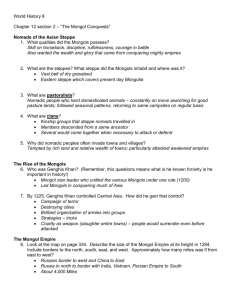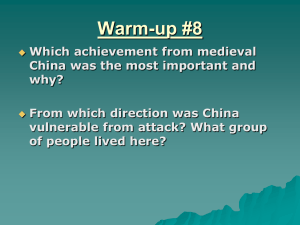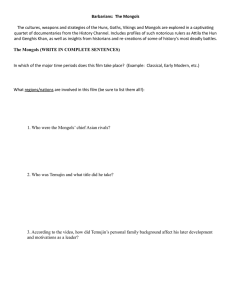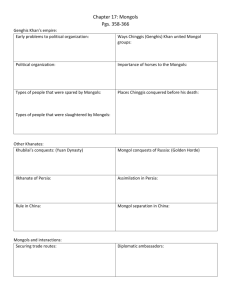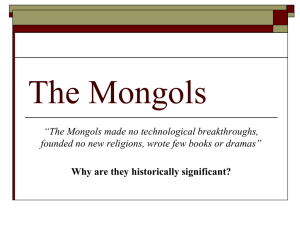Name: _____________________________ Date:
advertisement
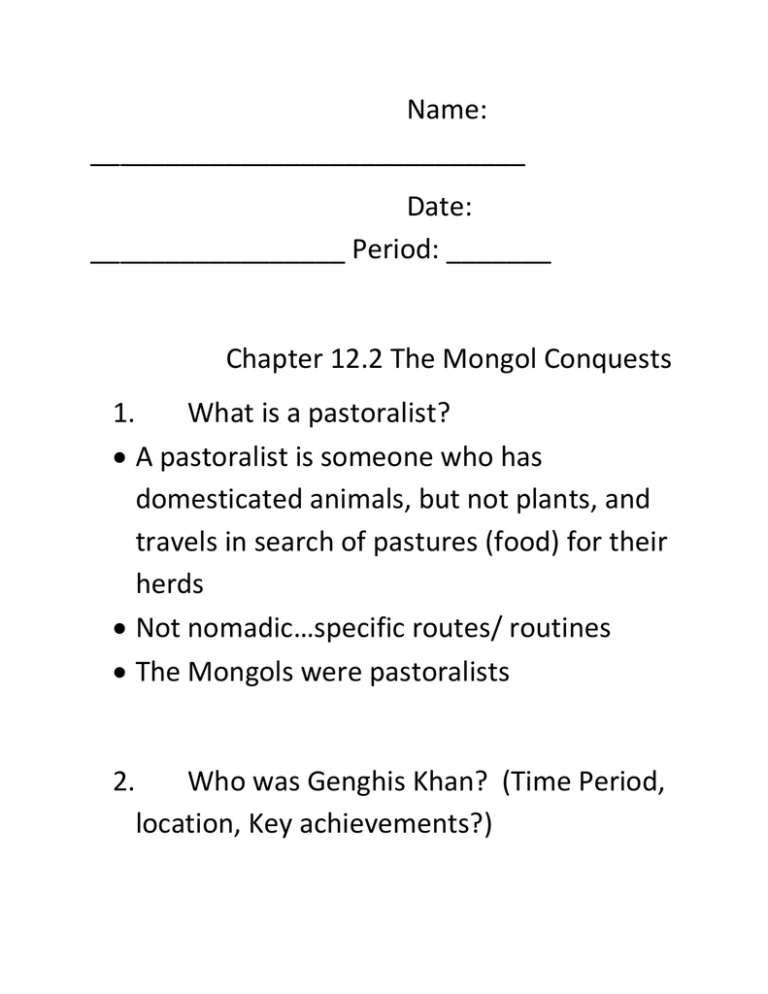
Name: _____________________________ Date: _________________ Period: _______ Chapter 12.2 The Mongol Conquests 1. What is a pastoralist? A pastoralist is someone who has domesticated animals, but not plants, and travels in search of pastures (food) for their herds Not nomadic…specific routes/ routines The Mongols were pastoralists 2. Who was Genghis Khan? (Time Period, location, Key achievements?) 13th century (1200’s)…Mongolia (central Eurasian steppe) Born as Temujin…named Genghis Khan, leader of the Mongols…conquered much of Eurasia Brilliant strategies…intimidating warrior 3. What was the Mongol Peace? Also known as the Pax Mongolica…in the 13th century…time of relative peace, after the Mongols conquered Eurasia…allowed for trade and stability throughout Mongol controlled lands. Chapter 12.2: The Mongol Conquests I. Nomads of the Asian Steppe Steppe: landmass of Eurasia from Manchuria to Hungary- vast belt of dry grassland called the steppe Steppe: 1. Land trade route connecting the East and the West…2. Home to nomadic peoples who swept into cities to plunder, loot, and conquer A. Geography of the Steppe Western steppe: Central Asia to eastern Europe…Hittites and Aryans Eastern steppe: area of present-day Mongolia, first home of Huns, Turks, and Mongols Short, hardy grasses…very little rain…extreme temperature ranges o -57degrees in winter, 96 degrees in summer Rainfall more plentiful in Western steppe than east…movement traditionally has been to the west and the south Boundaries of the steppe were constantly shifting…more political than geographical End of steppe-where cultivated fields began B. The Nomadic Way of Life Pastoralists- herded domesticated animals…constantly on the move, searching for good pasture to feed their herds. Nomads did not wander- followed a seasonal pattern and returned on a regular basis to the same campsites. Battles frequently arose over grassland and water rights Asian nomads- lived on horseback…followed huge herds over the steppe Depended on animals for food, clothing, and housing…diet of meat and mare’s milk…lived in portable felt tents called yurts Clans: kinship groups…common ancestors C. Steppe Nomads and Settled Societies Differing ways of life of nomadic and settled peoples resulted in constant interaction between them…engaged in peaceful trade…exchange of horses Nomads were accustomed to scarcity and hardship Settled peoples lived in constant danger of raids from nomads Occasionally, powerful group, like Genghis Khan and the Mongols, were able to conquer a whole empire…many became part of the civilization they conquered II. The Rise of the Mongols Mongol people had roamed the eastern steppe in loosely organized clans A. Genghis Khan Unites the Mongols Around 1200, Temujin, Mongol khan (clan leader) chose to unify the clans under his leadership o Defeated rivals one by one, showing no mercy 1206- Temujin was named Genghis Khan, “universal ruler” of the Mongol clans 1162?-1227…born with a blood clot in his fist…father poisoned by Taters when he was 9…family was abandoned by clan…grew to manhood, fought and defeated the Tatars…survivors (females and youngest male children) brought up as followers o “Man’s greatest good fortune is to chase and defeat his enemy, seize his total possessions, leave his married women weeping and wailing, (and ) ride his (horse)…” o Next 21 years, Genghis led Mongols in conquering much of Asia o Invaded northern Jin empire (Jurchens) in 1215…then turned to Islamic region west of Mongolia Campaign of terror across Central Asia…destroyed one city after anotherUtrar, Samarkand, Bukhara By 1221, Central Asia was under Mongol control B. Genghis the Conqueror Brilliant organizer Assembled Mongol warriors into a mighty fighting force…superb horsemen, all cavalry, covered as much as 120 miles a day…drink horse’s blood…stirrup was a key invention…short bow Genghis grouped his warriors in armies of 10,000…1,000-man brigades, 100-man companies, 10-man platoons Gifted strategist o Falling stars o Spies o Trickery Genghis adopted new weapons and technologies used by his enemies o Put captured Chinese engineers to work building catapults and gunpowder charges…used weapons to conquer other Chinese cities Genghis used cruelty as a weapon…believed in terrifying his enemies into surrender o Killing entire populations o Propaganda encouraged III. The Mongol Empire Genghis Khan died in 1227- from illness Successors continued to expand his empire Territory from China to Poland A. The Khanates After death of Genghis Khan, Ogadai became the Great Khan Mongol armies commanded by Genghis’s other sons and grandsons drove armies south, east, and west out of Inner Asia Completed their conquest of northern China and invaded Korea…leveled Russian city of Kiev…Ogadai died in 1241…commanders were called by to elect his successor (khuriltai) 1260: Mongol Empire was divided into four large khanates o Khanate of the Great Khan (Mongolia and China) o Khanate of Chagatai (Central Asia) o Ilkhanate (Persia) o Khanate of the Golden Horde (Russia) Kublai Khan, grandson of Genghis Khan, named himself Great Khan in 1260 B. The Mongols as Rulers Many areas invaded by the Mongols never recovered o Destruction of irrigation systems in Tigris and Euphrates valleys Over time: some Mongol rulers adopted aspects of the culture of the people they ruled Ilkhans and the Golden Horde became Muslims Growing cultural differences among the khanates contributed to the eventual splitting up of the empire The Eternal Blue Sky C. The Mongol Peace Mid-1200’s to the mid-1300’s, Mongols imposed stability and law and order across much of Eurasia…Pax Mongolica (Mongol Peace) o Mongols guaranteed safe passage of trade caravans, travelers, and missionaries from one end of the empire to another o Very active trade o Ideas and inventions traveled along with the trade goods…gunpowder o Bubonic plague
